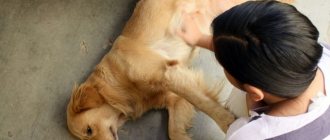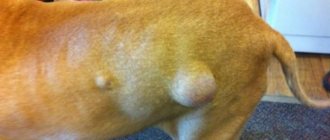A dangerous symptom of many diseases of domestic animals can be convulsive syndrome. Seizures in a dog are an unpleasant and frightening sight. Involuntary muscle contractions are often accompanied by profuse drooling, foaming at the mouth and loss of consciousness. It is very important to make a correct diagnosis. Only in this case can competent treatment be prescribed. Usually it takes place in two stages: symptomatic treatment alleviates the pet’s condition, and specific treatment eliminates the cause of the attacks and thereby prevents their recurrence.
But before the dog gets to the veterinary clinic, first aid should be provided to it by someone who is nearby. The owner needs to know what to do if his dog starts having seizures.
Seizure
Increased convulsive readiness can be provoked by pathological activity of neurons in those parts of the brain that are responsible for the motor control system. The magnitude of a convulsive attack can vary: from mild twitching of the muscles of the limbs to severe generalized seizures with loss of consciousness. It all depends on what size part of the brain is affected by the disease.
A classic attack consists of the following main stages:
- Aura. This is the period when seizures are approaching. It can be recognized by increased anxiety and increasing trembling of the limbs. It can last from a few minutes to several days.
- Hit. This is an acute period. Symptoms appear with the greatest brightness. The convulsions are particularly severe and the dog may lose consciousness. This stage is characterized by uncontrolled urination and increased salivation.
- The post-traumatic stage is a state of “stupefaction”. It is characterized by wandering of the animal, loss of orientation in space, confusion, and severe headache. May last for several hours.
Single, infrequently recurring attacks of convulsions are not life-threatening. But there are acute conditions called convulsive status. It is characterized by constant or frequently recurring attacks. In this case, the dog needs urgent medical attention.
Games on feelings
In real veterinary clinics there will be elements of “divorce”.
Veterinarians say that this is often determined by the client’s wallet. The greater the opportunity to pay for services and the more the owner worries about his pet, the more likely the animal will be prescribed additional immunostimulants, dietary supplements, water-soluble and fat-soluble vitamins, and special food. There are cases when this is really necessary (pedigreed, show animals, weakened after a serious illness). But it will be good if you ask your veterinarian in detail about the need for each appointment. Find out in detail about the results of the examination and analysis of your pet’s condition. Be persistent. Do not give in to attempts to intimidate you, be consistent in your questions. Consult a specialist who does not work at this veterinary clinic. If it turns out that half of the prescriptions are prescribed to enrich the veterinarian’s pocket, and not for the health of the animal, feel free to leave. And do not forget to leave a negative review about the organization - other owners may also suffer.
Causes
Seizures in dogs can have different causes. This is a fairly common symptom. In order to be sure that the seizures will not return, it is not enough to eliminate them. The disease itself must be cured.
- A bacterial or viral infection in a dog can cause complications in the brain. An example is meningitis or rabies. Rabies is one of the most dangerous viral diseases, which is practically incurable and almost always leads to death. The only way to protect yourself from it is to vaccinate your dog on time.
- Severe intoxication of the body. It is almost always the result of poisoning with pesticides or the bite of a poisonous insect. Arsenic is very dangerous for animals. The pet feels nauseous, muscle cramps may be accompanied by diarrhea, vomiting, intestinal cramps and other signs of poisoning. In this case, competent detoxification and gastric lavage with copious amounts of liquid can save the situation.
- Hypoglycemia is a severe deficiency of glucose in the body. With prolonged hunger or disruption of the pancreas, blood sugar can drop to unacceptably low levels. Hypoglycemic coma can result in a seizure and loss of consciousness. The disease is often hereditary. An injection of glucose into the muscle of the hind legs or a small amount of sweet syrup poured into the dog’s mouth relieves the attack.
- The consequences of brain or spinal injuries, electric shocks can give a convulsive response. Moreover, the reaction is often very distant in time.
- Diseases of the cardiovascular system can also have a neurological basis, expressed precisely through seizures.
- Tumor diseases of the brain or spinal cord are likely to be characterized by seizures and loss of sensation in the hind legs. Its presence depends on which part of the brain is affected by the disease. More common in older dogs.
- Liver disease, namely hepatic encephalopathy, is a very likely cause of seizures. Diagnosed in individuals who are already 5 years old.
- Infectious damage to the animal's nervous system by the canine distemper virus leads to convulsions and subsequent paralysis of the hind limbs.
- Vitamin deficiency and lack of microelements. With a lack of vitamins and beneficial chemical elements, the nervous system suffers the most. This is especially true for B vitamins, as well as magnesium and calcium preparations.
- Epilepsy is the most common cause of seizures in dogs. Large breed dogs are more susceptible to it. It is almost always a congenital pathology, so it is more often diagnosed in young individuals.
- The consequences of stress and nervous tension can also be expressed by an increase in convulsive readiness.
Small puppies often experience muscle twitching and slight cramps in their hind legs during sleep. They may move or move them, as when running. No need to be scared. Such conditions are not dangerous. They only indicate that the baby’s nervous system is too excitable. All animals need the attention and affection of their owner. To eliminate such symptoms, you need to strengthen the dog’s nervous system and leg muscles by walking with it in unfamiliar places.
Vomiting blood
Your pet is unable to recover on its own when hemorrhaging is accompanied by vomiting. If blood clots appear in the vomit, the foam becomes bloody, only surgical intervention by the veterinary service can help the animal. The symptom is typical during a rupture of stomach tissue as a result of a sharp object, such as a cufflink, getting into it. To save the dog's life, surgical assistance will be required.
Attentive attitude towards pets. Future dog owners should think before getting a pet whether they have the time and financial means to maintain an animal. A dog requires close attention, patience, time and appropriate care from the breeder; it is essentially the same as a child. She no less needs education and training.
Your pet can get sick at any time and urgently need help. The owner’s clearly coordinated ability to act in emergency situations will help avoid tragedy. Do not leave the animal unattended, and in case of poisoning, initially try to give it water to drink without coercion.
Types of seizures
A cramp is an involuntary contraction of muscles. They tense, become hard, and become deformed. Such strong tension often accompanies pain. The brain, nerve fibers, muscle tissue, and endocrine system can take part in the formation of a seizure.
In dogs, seizures can vary in intensity and duration. There are 4 types of involuntary muscle contractions:
- Convulsions are rhythmic twitching of large muscle groups. They are usually not accompanied by changes or loss of consciousness. They last from several seconds to several minutes, sometimes accompanied by pain.
- Tonic cramps are a series of short-term muscle spasms. Affects the muscles of the abdomen, neck, legs. One large muscle may be involved.
- Clonic seizures are characterized by twitching, a rapid alternation of contractions and relaxations. May be characterized by movement disorders and impaired coordination of movements.
- Generalized cramps are diffuse in nature and affect many muscle groups. The dog falls sharply. Convulsive movements shake the whole body, usually foaming at the mouth. Such conditions are especially characteristic of epilepsy and epileptic syndromes of various etiologies and are often accompanied by loss of consciousness.
When to rush to the vet
It is necessary to visit a veterinary clinic if the dog lies and twitches regularly, and the danger is posed by both short-term and rare attacks and frequent, long muscle contractions. Cramps are also a reason to visit a specialist, as they often indicate developing problems in the body.
It is necessary to bring a dog to the clinic that has seizures after birth, since treatment in such cases can only be carried out by a doctor. In case of poisoning, you need to take the animal to the veterinarian within half an hour after consuming the poison.
Important! Epileptic pets should be seen by a doctor if the seizure lasts for a very long time.
Seizures in a puppy should cause concern to owners if they are severe and occur regularly. Don't worry if your pet twitches while sleeping. This is an absolutely normal phenomenon that does not require medical intervention.
Seizures are a symptom of a large number of different diseases. To keep your pet healthy, you need to visit a veterinarian who will select treatment.
First aid
Sudden convulsions in a beloved dog should not lead the owner into confusion. This symptom is not so scary. Much more serious consequences can arise from injuries that the dog can inflict on itself during an attack. Therefore, the owner’s main task is to reduce this risk to a minimum. The most correct actions would be:
- make sure that the animal cannot get hurt; for this purpose, make sure that there are no piercing or cutting objects nearby;
- put the dog not on the bed, but on a soft bedding placed on the floor;
- hold the animal’s paws and head;
- put it on its side to prevent choking, make sure that foam and saliva flow freely from the mouth;
- to avoid damage to the dog’s teeth, try to insert an object (a spoon) between the jaws;
- carefully drop a few drops of a sedative (Corvalol or Valocordin) onto the tongue, this will help the attack end sooner;
- observe the dog’s behavior in order to later correctly describe its condition to the veterinarian;
- Call a veterinary service at home as soon as possible or, after waiting for the attack to end, bring the dog to a veterinary clinic.
It happens that the convulsions are quite prolonged; only an experienced veterinarian knows what to do in this case. Attempts to treat an animal with home methods can only worsen the situation.
Find the answer
Do you have any problem or question? Enter “Breed” or “Name of the problem” into the form, press Enter and you will find out everything about the issue that interests you.
You should monitor your pet when vomiting becomes periodic. The presence of diseases of the stomach or intestines cannot be excluded. Often white vomit is a protective mechanism that cleanses the pet’s body of toxins during viral diseases or poisoning.
Survey
Diagnosis of a neurological disease includes a set of instrumental examinations aimed at identifying its cause. Since this symptom can be caused by a number of ailments of a very different nature, the diagnosis should be as comprehensive as possible. When making a diagnosis, the patient’s age and lifestyle are always taken into account.
The owner needs to find out whether any of the dog’s ancestors had similar symptoms. It is also very important to remember whether the dog had significant injuries or head hits.
The following types of surveys are the most informative:
- magnetic resonance and computed tomography of the brain and spinal cord;
- ultrasound examination of the abdominal cavity;
- radiography of the bones of the skull and spine;
- electrocardiogram of heart contractions;
- detailed blood test.
It must be borne in mind that seizures in an elderly person may often indicate liver disease, kidney disease, or heart problems. Puppies and young dogs are more often susceptible to epilepsy, and calcium deficiency (eclampsia) is experienced by pregnant and lactating females, as well as small breed dogs.
Who is at risk?
Seizures are most often observed in small breed dogs. This is explained by their tendency to low blood glucose levels, and, accordingly, to hypoglycemic attacks. Also, miniature individuals more often suffer from eclampsia - a sharp increase in blood pressure.
Males are more susceptible to seizures: males are much more prone to epilepsy and neurological disorders than females.
This disease is common in collies, dachshunds, poodles, Labradors, huskies, and boxers. These breeds are at increased risk of congenital or acquired epilepsy.
Treatment of the disease
Before a diagnosis is made, treatment of seizures in dogs can only be symptomatic, that is, it relieves the main symptoms and improves the general condition of the animal. Anticonvulsant therapy begins with intramuscular injections of magnesium sulfate (magnesium). Based on the diagnostic results, the doctor determines the main cause of seizures and prescribes specific treatment to the patient. It may happen that the animal may need medications to relieve neurological symptoms for the rest of its life.
The owner is required to strictly follow all the doctor’s recommendations. You cannot stop prescribed therapy without permission to avoid recurrence of attacks.
Features of feeding
If the cause of vomiting is motion sickness, overheating, or swallowing missing food or a foreign object, temporarily change the dog's diet. Eliminate fatty, hard-to-digest foods. Instead, give fermented milk drinks, vegetables and cereals, mashed to a puree consistency.
If vomiting is a symptom of a disease of the digestive or nervous system, put your pet on a diet until complete recovery. The menu should be drawn up by a veterinarian after determining the age, severity of the disease, and allergic reactions. Remember, therapeutic nutrition is a mandatory part of therapy.
Prevention measures
There is no special system for preventing these conditions. The main means of prevention are, first of all, a healthy lifestyle - good nutrition, walks with the dog in the fresh air, active games. Regular preventive examinations are important to ensure that the onset of the disease is not missed. Seizures in dogs of most small breeds can begin after suffering stress, because they are very timid. We must ensure that such situations are created for them as little as possible.
Pedigree dogs are most predisposed to this disease. Why this is so is still unknown. Dogs of the poodle, husky, and dachshund breeds are often diagnosed with epilepsy, and Yorkshire terriers, Chihuahuas, and Spitz dogs are susceptible to hypoglycemia.
Video “Epilepsy attack in a dog”
The video shows a spasmodic attack in an animal of the husky breed. The owners are trying in every possible way to help their pet, as this is described in first aid for seizures. The main thing is to calm the animal and yourself!
Was this article helpful?
Thank you for your opinion!
The article was useful. Please share the information with your friends.
Yes (100.00%)
No
X
Please write what is wrong and leave recommendations on the article
Cancel reply
Rate the benefit of the article: Rate the author ( 10 votes, average: 4.30 out of 5)
Discuss the article:
Diagnosis of the disease
As Alexander De Lahunta writes, an accurate diagnosis of pug encephalitis is made only after the death of the animal: an autopsy (autopsy) is performed and the nervous tissue is examined under a microscope.
Unfortunately, the practice of Russian veterinary medicine confirms the dispassionate conclusions of De Lahunta . In our country, the overwhelming number of doctors do not know how to diagnose the disease at its initial manifestations. Very often, veterinarians, not knowing the specifics of the breed, diagnose pugs with epilepsy.
This is interesting! When trying to classify the disease, they usually send the dog for a magnetic resonance imaging scan. MRI is not a cheap diagnostic method, and not every pug owner is willing to spend a lot of money (taking into account the bleak prognosis of the disease).
Alexander De Lahunta, as a practicing specialist, claims that the best results in his center are also obtained during intravital study of material taken before the euthanasia of the animal. After he is euthanized, the infected tissues are placed in formaldehyde and stored in complete isolation.
It is clear that the capabilities of an American university are incomparable with the material base of domestic veterinary medicine, which is forced to cope with pug encephalitis using much less advanced methods.
Return to content
Description of the disease
It first appeared in 1983 in the textbook “Veterinary Neuroanatomy and Clinical Neurology” (2nd edition), written by Alexander De Lahunta, Doctor of Veterinary Medicine, from Cornell University in the USA.
Encephalitis affecting pugs was diagnosed in the middle of the last century, more precisely, in the 60s in the state of California . Nowadays, the diagnosis is made not only in America, but also on the Australian and European continents.
Alexander De Lahunta, who conducted meticulous microscopic studies, claims that the symptoms of the disease differ from known forms of encephalitis in other canine breeds. That is why the scientist recognized it as characteristic (specific) only for a single breed, calling it pug encephalitis.
Doctors working in the field of veterinary neuropathology studied the data obtained in the laboratories of Cornell University and were forced to confirm that the disease is species-specific, that is, it is detected exclusively in pugs.
Important! Research conducted by A. De Lahunt did not give an exact answer to the question of the origin of this terrible disease. It is not surprising that veterinarians still cannot agree on the causes of severe brain damage in pugs.
American biologists found signs indicating the infectious nature of the disease, but failed to find the source that triggered it. Now encephalitis is called the scourge of pugs. The situation is aggravated by the lack of competent publications and the powerlessness of doctors in the fight against idiopathic encephalitis.
Nevertheless, the disease exists, as evidenced by the disappointing veterinary statistics of the countries where pugs are bred and kept.
Return to content
Preventive measures
To avoid poisoning while walking, teach your dog the commands “Fu!”, “No!”. Do not feed your pet leftover food from your table or give it spoiled food. Prepare separate meals for your animal without spices, with minimal addition of salt. To kill worms, freeze raw meat and fish for three days.
Bring your dog for vaccinations and medical examinations in a timely manner. Do not self-medicate if you experience diarrhea with bloody discharge or deterioration in coordination of movements. To avoid overdose of medications, consult your veterinarian before using them.
What it is?
Epilepsy is a disease of the central nervous system, which is characterized by a paroxysmal course and periodic seizures in an animal, which are often accompanied by convulsions.
As a rule, this disease does not pose a mortal threat to pugs, but the quality of life is greatly reduced. An attack can begin at any moment; it is almost impossible to predict when and for what reason it will happen.
There is an opinion that epilepsy develops due to a pathology of the body's bioelectrical system, in which cells of the brain and nervous system are affected due to increased electrical activity.
During seizures, which can be accompanied by convulsions of varying strength, a group of neurons in one part of the brain loses electrical stability. This leads to a powerful discharge that affects surrounding cells and prevents them from functioning normally.
Kinds
There are two types of disease.
True (idiopathic, primary) epilepsy. The reason for its appearance is currently unknown. Scientists suggest that this type of disease is caused by genetic disorders in the animal's body.
The first seizure in a pug with true epilepsy can occur between the ages of 6 months and 5 years. At first, seizures may appear once a year or even less frequently, but over time, in the absence of proper treatment, the frequency of seizures increases and turns into status epilepticus, in which seizures occur almost continuously.
There is no method by which individuals with disorders can be identified in advance. Experts believe that the likelihood of developing primary epilepsy increases significantly when closely related individuals are crossed.
Secondary epilepsy. In this case, the cause of the pug’s seizures can be determined; it occurs due to the influence of various factors that affect the cells of the central nervous system.
Forecast and consequences
To date, there are no methods or medications that can completely cure epilepsy. The main goal of therapy is to control seizures and minimize their effect on the pug’s body and prevent prolonged seizures.
Important! A pug suffering from epileptic seizures should be surrounded by care and affection, he should be provided with a calm environment and increased attention.
It is important to understand that although keeping a dog with epilepsy requires certain conditions, the prognosis for this disease is quite favorable. If a pug receives adequate treatment, it will be difficult to distinguish it from its completely healthy counterparts.
If you carefully follow your doctor's recommendations, an animal with epilepsy can live a long and fulfilling life.
Characteristic signs of poisoning
Symptoms of poisoning are usually characteristic. Symptoms arise quickly, and an attentive owner will easily detect them. The most characteristic signs of food poisoning:
- Excessive hypersalivation (saliva production).
- Trembling throughout the body, cramps in the limbs.
- General weakness and malaise.
- Vomiting and diarrhea.
- Frequent shallow breathing and palpitations.
- Change in the animal’s consciousness – depression or excitement.
- Refusal of food, water, or vice versa, severe thirst.
- Analyzes show signs of an inflammatory process.
When eating poison for rodents or isoniazid, signs of internal hemorrhages, agitation, signs of confusion, foam from the mouth, and convulsions develop.











